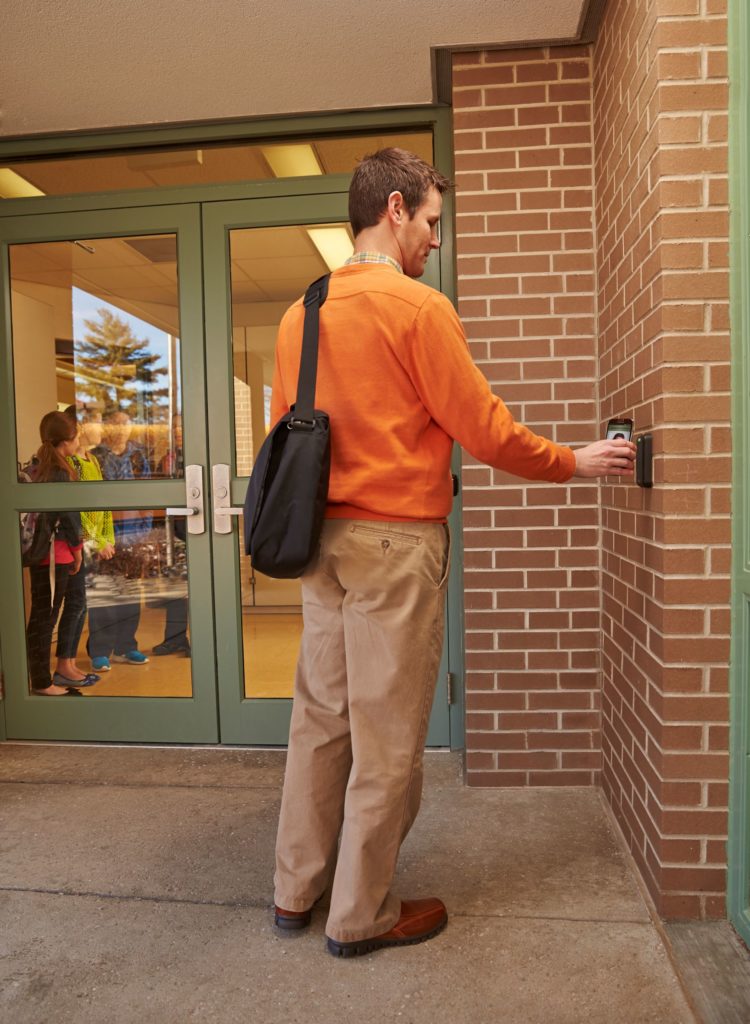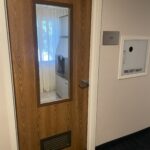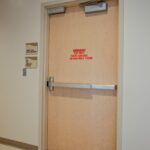By now we have all read or watched multiple news accounts of last Friday’s shooting at Santa Fe (Texas) High School, where 8 students and 2 teachers were killed and 13 people were injured. I feel somewhat helpless as I hear of yet another shooting, but all I can do is continue to learn and teach about the role played by physical security. Details are sketchy at this point, but some reports mention the assailant shooting through glass. More information about doors, locks, and access to the classrooms will follow as the investigation continues.
One headline that caught my eye was from the Washington Post: “Texas official says that fewer doors could mean fewer school shootings. We had experts weigh in.” In response to the shooting, Lt. Gov. Dan Patrick pointed out that the school had experienced the shooting despite having received a safety award from the state and having two police officers on site. He went on to say, “We may have to look at the design of our schools moving forward and retrofitting schools that are already built. And what I mean by that is there are too many entrances and too many exits to our more than 8,000 campuses in Texas,” he said, citing security at office buildings and courthouses. “Had there been one single entrance possibly for every student, maybe he would have been stopped.”
 The response to these comments was harsh. Could “too many entrances and too many exits” really be blamed for this senseless shooting? While reducing the number of exits is probably not feasible and will not solve the problem, schools DO need to limit the number of access points – preferably incorporating a security vestibule and access control at the main entrance, using access control at other entrances, and monitoring all exits. Not necessarily reducing the number of entrances and exits, but controlling and monitoring them.
The response to these comments was harsh. Could “too many entrances and too many exits” really be blamed for this senseless shooting? While reducing the number of exits is probably not feasible and will not solve the problem, schools DO need to limit the number of access points – preferably incorporating a security vestibule and access control at the main entrance, using access control at other entrances, and monitoring all exits. Not necessarily reducing the number of entrances and exits, but controlling and monitoring them.
With that said, this can be difficult for a campus setting like Marjory Stoneman Douglas High School in Parkland, Florida, where students and staff may move between buildings during the school day. And having all students enter through one access point might have led to the discovery of the weapons used in Friday’s shooting in Texas, but when the assailant is a student or another person who is authorized to be in the building, weapons may be concealed and go unnoticed until it’s too late.
I am completely in favor of securing perimeter doors to prevent unauthorized access, and supervising entry points. But exits are critical to maintain, as the ability to evacuate is an important part of each school’s emergency response plan. As with classroom doors, it’s crucial to consider all factors and the potential consequences of the security methods deployed.
~~~
A letter from a parent of a Santa Fe shooting survivor was published on CNN. Although it is not an official police report, it gives some detail about what happened in the art classroom, including mention of a locked door: “She said everything happened so fast and everyone is panicking and running around the room. There’s a door at the back of the room to which the kids are running…only to discover the door is locked and they are trapped.”
There will undoubtedly be a push to add classroom barricade devices to existing doors in Texas schools, but in a survey compiled by the National Association of State Fire Marshals, the Texas State Fire Marshal reported that classroom barricade devices are not allowed in Texas schools. The model codes require doors in a means of egress to unlatch with one releasing operation (all latches simultaneously), so adding a barricade device to a door with existing latching hardware is not compliant with the model codes.
Another news report mentioned the fire alarm: “Zach Wofford, a senior, said he was in his agricultural shop class when he heard gunfire from the art classroom across the hall. He said substitute teacher Chris West went into the hall to investigate and pulled a fire alarm. ‘He saved many people today,’ Wofford said of West.”
There has been a lot of discussion since the shooting in Parkland, Florida, about whether schools should delay evacuation when a fire alarm sounds, to give administrators time to decide whether to evacuate. If the fire alarm was pulled by a Santa Fe teacher and allowed students to safely exit, this will add to the debate about whether students should evacuate immediately upon fire alarm or shelter in place. I am doing some research into current state policies regarding delayed fire alarm notification in schools, and I will share this information in an upcoming post.
You need to login or register to bookmark/favorite this content.






Maybe fewer shootings. Inside. The building
Something that has been popping up all over my social media feeds, “Maybe we should stop electing morons to public office.”
Look. We already secure airports, federal buildings, and local courtrooms. It’s time to add schools to that list.
Some newer, “more secure” schools have a policy of limiting number of access points during the morning arrival time for students (to, perhaps, 2 or 3) and then, at class start time, to restrict access to only the security vestibule main entry. Considering how conceal-able many firearms are, that still is unlikely to create total safety (especially for a student-gunperson). Most any glazed exterior door with a panic device could be easily compromised, so at most, it would be possible to know which door was the point of intrusion if door was monitored.
“Campus” schools have challenges.
Early coverage of the Texas event said the shooter came in with other students. He was, after all, a student.
Up here in Washington, where schools are required to have fire detection and sprinklers, fire-alarm pull stations at every exit door are a thing of the past. The explanation on that was to avoid a perpetrator activating the pull station to get more targets into the hall. However, many schools with such a setup also have immediate evacuation as step #1, when possible. Clearly not all figured out.
I’m not convinced we have more openings than we need. That is mandated by building occupancy codes and requirements. What I would agree with is we should perhaps manage them differently. Openings should be classified as Primary or Secondary/Tertiary openings. Primary openings are main entrances and maybe some event entrances. These are the entrances we want people to use to enter and exit the building under normal conditions. Security vestibules should be utilized at the Main Entrance to the building to manage student arriving as well as handling visitor management. Limiting the use of entrance points to buildings, much like we see at airports, gives us the opportunity to have visual control of those entering the building. It is less convenient, but security and convenience are necessarily somewhat mutually exclusive. Higher degrees of security are less convenient (see airport comment). Secondary/Tertiary openings exist for primarily one reason – to evacuate the building in the event of an emergency. They should be closed, locked at all times and monitored (door position and latch position) at all times.
Any security expert will tell you the perimeters or layers of security are designed to detect, delay and deter those who mean to do harm.
Not surprising considering previous statements this Lt Governor has made.
Here is an animation of the Parkland shooting. There is also an accompanying frame-by-frame description. This is the kind of detail you need to propose an intervention strategy and serve as a basis for a security designer to ask more detailed questions about the event. Given what you see from this description, what would you suggest could have slowed down the progress of the shooter? What additional questions would ask if you could talk to the investigators or visitors?
https://www.nbcmiami.com/news/local/Marjory-Stoneman-Douglas-High-School-Parkland-Shooting-Timeline-481070621.html
Hi Jim –
I found that video very enlightening, and I posted some thoughts last month: http://idighardware.com/2018/04/msd-commission/. When the assailant is a student who is authorized to be in the building it’s especially critical to prevent/delay access to individual rooms, and to compartmentalize the building – while still allowing free egress. There are several options for lock functions to be used on classrooms and other spaces – there are pros and cons to each and the decision comes down to the district’s preference and budget. But the important thing is for those doors to be lockable. There is a lot that can be done to limit the movement of the shooter through the building without obstructing egress – typically electrified trim on panic hardware/fire exit hardware, or doors that have mechanically-locked lever trim but are held open electrically. I have a couple of recent posts on compartmentalization:
http://idighardware.com/2018/04/school-security-compartmentalization/
http://idighardware.com/2018/05/special-purpose-doors-for-compartmentalization/
– Lori
A year ago our school district hired security contractors to upgrade access control at the two high schools. The result was magnetic locks on EVERY exterior door. All 6 doors at the main entrance, doors at the bottom of stairways, doors exiting the gym, the auditorium, the art room, etc. Many if these doors are exit-only with no cylinders, pulls, or levers on the exterior. These mag locks had no RX sensors or switches in the exit devices. The ONLY means of releasing them was through the security system or Fire Alarm.
This was a security vendor’s idea of how to prevent somebody inside from admitting an unauthorized person. The result resembled a detention facility. Kids would occasionally get locked in the pool, gym, etc when they over-stayed the programmed unlock period. This clearly violated NFPA 101 and building codes.
When I approached the school board president, she already knew they had issues, and removal of the mag locks was planned.
Ideally every exterior door would be ALARMED with video camera coverage at every point of alarm, but free egress maintained at all times.
Oh no! Schools are trying to add security without breaking the bank, so I especially hate to see bad decisions/advice like this!!
– Lori
I’ve been advocating for a locked classroom policy during instruction and other upgrades in my children’s school district and my state for the last few months. There are many school districts that already have this policy in place, but it seems to me that there is a general lack of understanding of how door locks are function and people don’t seem to want to change their habits. Locking the doors may be an inconvenience but aren’t the lives of our children and teachers worth a little inconvenience? We are willing surrender our convenience at airports, why not schools? It’s crazy to me to ask a teacher to go to the classroom door and lock it once a shelter in place alarm is sounded. It puts their life in danger as well as the students.
I do think fewer points of entry into schools should be reviewed across the board, along with monitoring and shatter resistant film at entry/exit points and classrooms. We install blue light warning systems in the offices we design for one of my clients. This is to alert the staff that there is a disgruntled person in the reception area and the receptionist (who is behind a sliding window) feels threatened. Maybe we should be looking into another type of alarm implementation for shelter in place/active shooter situations so as not to be confused with a fire alarm.
I agree that in todays world we need higher security for our schools but you need to consider who is shooting our kids. For the most part, it is the kids who should be on campus in the first place that are responsible for these shootings. It doesn’t matter how many entrances or exits there if you don’t know who you are looking for.